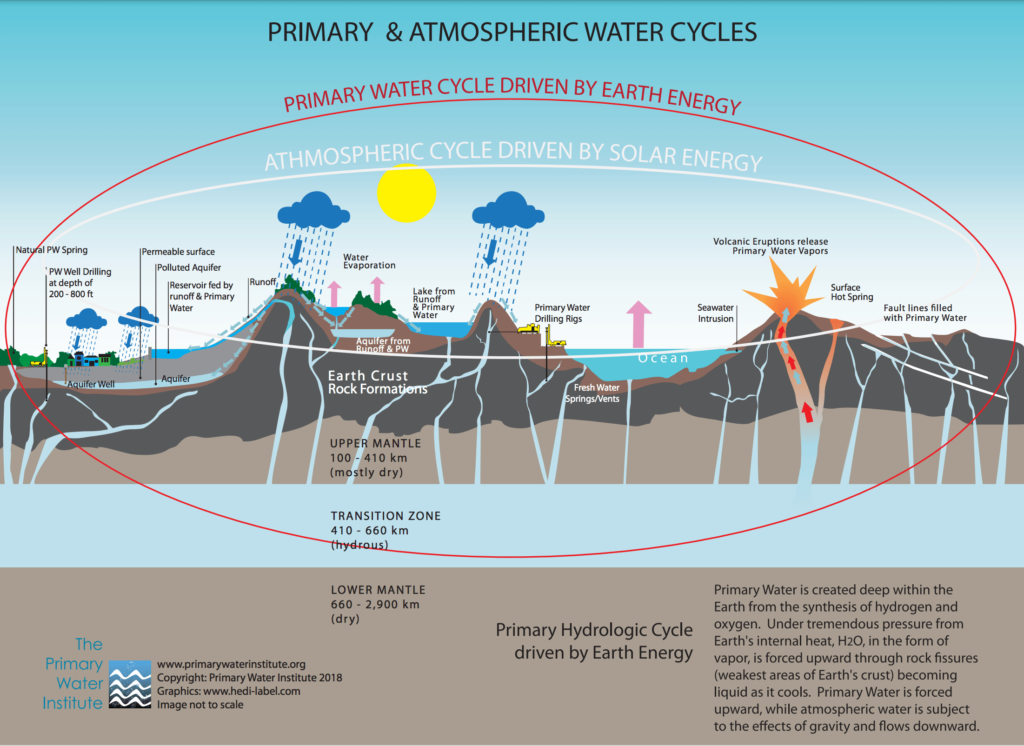What if I told you that Earth’s most abundant source of water is actually found deep in its core? This water is stored in rocks and magma, and is only released when there is a geologic event (such as an earthquake or volcanic eruption). What if I also told you that this underground water supply may be 2-3 times larger than all the water in our oceans? And what if I said that we could easily access this hidden reserves by drilling into the earth?
Although seldom acknowledged, the Earth’s magma and geology is the source of our planet’s cleanest water, which is mentioned in the Bible and other ancient texts. This water can be found in unusual locations such as mountain springs and desert oases. Have you ever been perplexed by how a spring might defy gravity and rise to great heights on top of a mountain or become a lush green refuge in the middle of a desert? Although there is no mystery regarding primary water, which has been largely concealed and only recently began to be openly discussed inside scientific communities, access to it has historically been limited.

The purity of Primary Water, in addition to its profusion, is that it is fresh water that has never been exposed to the air. As previously said, access is largely determined by geography and geology rather than climate and atmospheric rainfall. It’s plentiful in drought years as well as any other year with normal rainfall. It may also be confined to certain regions and locations, and it may exist in great quantities if proper geological conditions are met.
All water on Earth first comes from Primary Water deep in the mantle of our planet. This type of water is under immense pressure and slowly rises to the surface through cracks and fissures, taking the form of volcanic steam, artesian springs, geysers, and oases. What makes Primary Water so special is that it has never been exposed to pollution on Earth’s surface before. As Primary Water nears Earth’s surface, it becomes part of the Hydrologic Cycle by mixing with water that is already present. Experts in this field are able to locate the water as it approaches the surface, which then reduces the depth needed for drilling water wells.
In Australia, the United States, and Africa, thousands of Primary Water wells already provide fresh water. In many villages in Africa, due to Primary Water wells, their quality of life has tremendously improved. Since it is a valuable source of water that could help refill reservoirs and support agricultural needs (just to list a few examples), Primary Water also has the potential to resupply over-tapped rivers such as the Colorado River.
Could Primary Water be the solution to our global water crisis? And, might Primary Water offer hope for mankind – and the future survival of Planet Earth? Absolutely! Primary Water may well provide relief from water shortages and hunger around the world.
We’d like to share the life-giving and bountiful prospect that Primary Water has for the world, and we invite you to dig into and discover all of the information available here about this amazing water source. Welcome to the realm of Primary Water!
READ MORE: A NEW PERSPECTIVE ON SOURCE OF THE POST-NAPA QUAKE WATER
Experts are debating how the new water is flowing into local creeks in Solano County, California, just days after the recent Napa earthquake. With at least 200,000 gallons of water per day gushing from Wild Horse Creek, and many other locations reporting comparable conditions, officials say it’s a wonderful blessing for locals. The new water has been added to municipal drinking water supplies…a significant benefit to local people.
Although some scientists report that the new flow of water is likely due to “shallow groundwater” suddenly released from opening of fractures, other theories remain hopeful for a drought-ridden world.
Pal Pauer, an American hydrologist, recently said in an interview that the post-earthquake water release is a great model of “primary water.” This kind of water does not come from aquifers near the surface that rely on rainwater; it comes from much deeper sources. These primary water sources are not affected by rainfall and seem to be never-ending. The science behind primary water might not be widely known yet, but there is strong evidence backing its existence.
A scientific study recently discovered vital water resources locked beneath the earth’s surface. The study confirmed “that there is a very, very large amount of water that’s trapped in a really distinct layer in the deep Earth…[ ]approaching the sort of mass of water that’s present in all the world’s ocean.”
In fact, a recent study reported in the SCIENTIFIC AMERICAN documented the presence of vast quantities of water locked far beneath the earth’s surface. That study confirmed “that there is a very, very large amount of water that’s trapped in a really distinct layer in the deep Earth…[ ]approaching the sort of mass of water that’s present in all the world’s ocean.”
Pauer stated that while primary water typically comes from deep Earth processes, it can be accessed close to the surface. This is because primary water usually seeps up through cracks in the Earth’s crust (represented in the diagram). The high pressure within the Earth’s mantle makes this possible and inevitable. You don’t have to drill hundreds of miles underground to access primary water, which is an abundant and valuable resource. In some cases, it’s actually accessible at the surface of the earth through natural springs. You can also find it by drilling less than 200 feet from the surface in other cases. Additionally, earthquakes like recent one in Napa can remove blockages and open channels for primary water, making this great gift suddenly available.
Pauer points to other clues that the water in Solano County is primary water. For one, there were almost no reports of sinkholes or land collapsing when the water was released. Also, if this much water had come from a shallow aquifer, an equal amount of depleting would have been happening rapidly (over 10 times quicker than before the quake). If not, then huge sinkholes or collapses would have happened.The absence of sinkholes or subsidence suggests that the source of these new waters is not a shallow aquifer, but rather a primary source that comes from much deeper, prolific sources. Even as huge volumes of water were discharged, these primary water supplies were so profuse that they were able to maintain surface stability while still retaining enormous quantities. Flow variations are possible until equilibrium is reached in situations like this, as depleted aquifers are replenished by primary water.
Pauer has overseen numerous successful primary water studies and drilling projects over the years, demonstrating that it is possible to access this hidden water source. Primary water can be detected on its own or combined with secondary sources like aquifers. As more people catch wind of this underreported science, maybe the Napa earthquake will go down in history for spurring us to look for drought solutions closer to home instead of searching vainly elsewhere.

